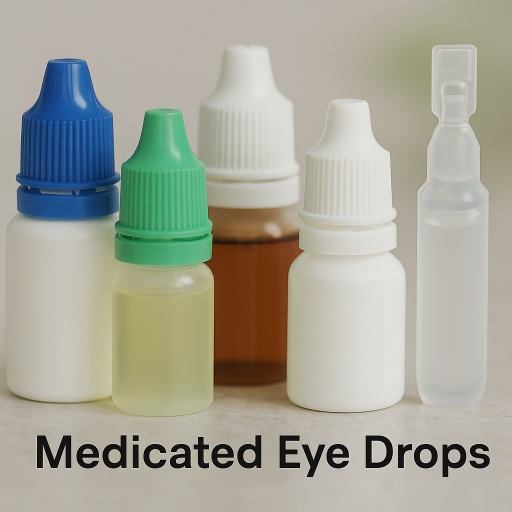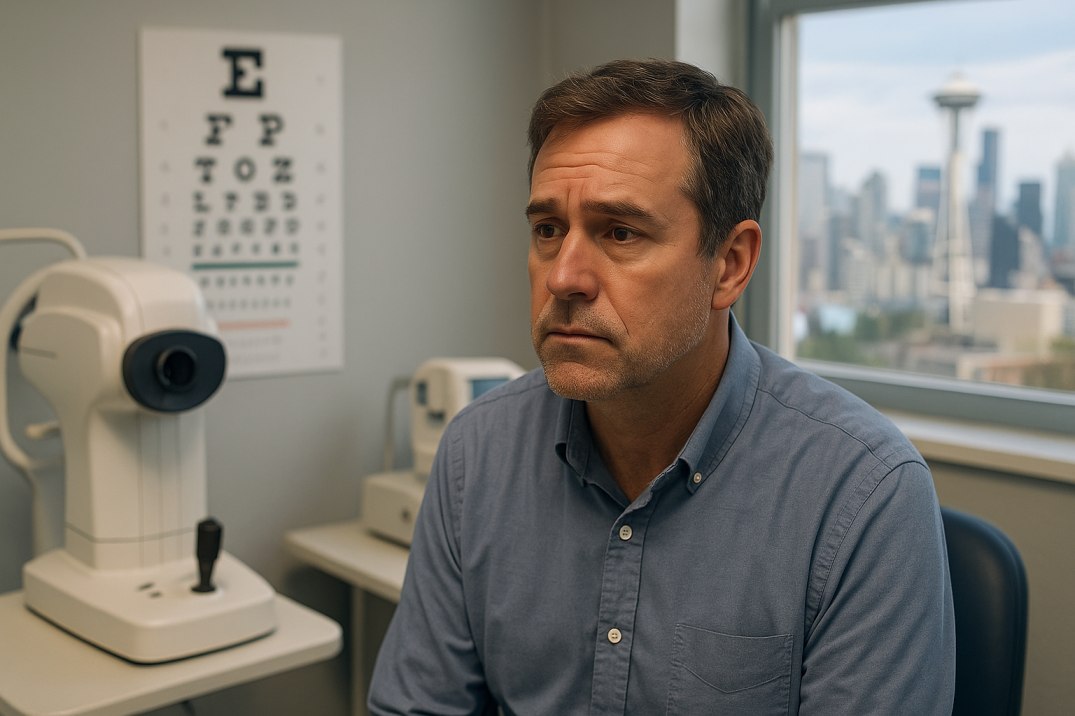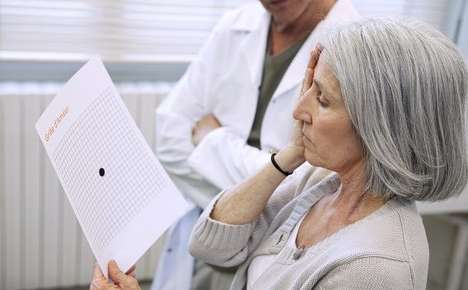Medicated Eye Drops: Uses, Types & Application Tips
Medicated eye drops are specialized solutions applied directly to the eye’s surface to treat infections, allergies, or dryness. Unlike oral medications, they deliver targeted treatment right where needed, minimizing whole-body side effects.
Key Takeaways: Medicated Eye Drops for Seattle Residents
-
Targeted Relief with Fewer Side Effects: Medicated eye drops treat issues like infections, allergies, and dryness by acting directly on the eye—minimizing whole-body effects compared to oral medications.
-
Match Drops to Conditions: Antibiotics fight infections, anti-inflammatories reduce swelling, lubricants combat dryness, and allergy drops relieve seasonal irritation—know which type you need before use.
-
Application Technique Matters: Following the 6-step method—especially pressing the inner eye corner after application—boosts effectiveness and minimizes side effects like bitter taste or blurry vision.
-
Store Smart for Seattle Weather: Keep drops in cool, dry places. Avoid freezing in winter or overheating in summer. Use insulated pouches for outdoor adventures.
-
Know When to See a Doctor: If symptoms last more than 72 hours, vision changes, or reactions worsen, consult a Seattle eye clinic immediately—especially during allergy season.
-
OTC vs. Prescription: Use OTC drops for mild, short-term issues. See a professional for persistent symptoms or chronic conditions like glaucoma or post-surgical care.
-
Safety First: Never share eye drops, always check expiration dates, and replace drops after infections to avoid reinfection.
How Seattle residents can benefit:
-
Penetrate the eye’s surface layers to reach affected tissues
-
Vary by function: Reduce inflammation, fight infection, or lubricate dry eyes
-
Require proper application technique (ask your Seattle eye doctor for a demo!) since natural blinking and tears can wash them away quickly
Top Medicated Eye Drops Used by Seattle Patients
-
Antibiotic Drops
-
Treat Seattle eye infections like pink eye (conjunctivitis)
-
Common brands: Vigamox®, Ciloxan®
-
Note: May cause mild stinging – consult your Seattle eye clinic if severe
-
-
Anti-inflammatory Drops
-
Steroids: Reduce swelling post-surgery or injury
-
NSAIDs: Ease pain from conditions like iritis
-
Tip: Never use without a prescription due to glaucoma risk
-
-
Lubricating Drops (Artificial Tears)
-
Combat Seattle’s dry winters and screen fatigue
-
Popular picks: Systane® Ultra, Refresh® Tears
-
Local advice: Carry for Pike Place Market wind exposure
-
-
Allergy Drops
-
Relieve pollen-triggered itch (common in Puget Sound spring)
-
Trusted brands: Zaditor®, Patanol®
-
Apply before Seattle outdoor activities for prevention
-
Mastering Eye Drop Application: Essential Guide for Seattle Residents
Proper technique maximizes medication effectiveness while preventing contamination – critical for Seattle’s active lifestyles.
6-Step Seattle-Approved Application:
-
Sanitize: Wash hands with soap (especially after Pike Place Market visits or transit use)
-
Position: Tilt head back, gently pull lower lid to form a “pocket”
-
Aim: Hold the dropper 1 inch above the eye without touching surfaces
-
Release: Squeeze one drop into the pocket
-
Absorb: Close your eyes, press the inner corner (near nose) for 60 seconds*
-
Wait: Pause 5+ minutes before other drops
Why press? Prevents drainage to throat (reduces bitter taste & systemic side effects)
Pro Tips from Seattle Eye Doctors:
-
Store drops properly: Avoid leaving in cars during Seattle’s temperature swings
-
Use the mirror technique if struggling (common with arthritis)
-
Ask your Seattle clinic about auto squeeze aids for steady hands
-
Carry travel-sized drops in reusable bags for Puget Sound adventures
Navigating Side Effects: When Seattle Residents Should Take Action
Common Temporary Reactions:
-
Quick stinging or mild burning (typically fades in 30 seconds)
-
Short-term blurred vision (avoid driving until clear)
-
Morning crustiness (especially during Seattle’s allergy seasons)
Seek Immediate Care at a Seattle Clinic If You Experience:
- Sharp pain or sudden vision changes
- Redness/swelling lasting >24 hours
- Allergy signs: facial rash, swollen eyelids, or breathing difficulty
Prescription vs. OTC Eye Drops: Making the Right Choice in Seattle
Prescription Drops → For Complex Conditions
-
Targeted Therapy: Stronger medications like cyclosporine (chronic dry eye)
-
Professional Oversight: Requires diagnosis/monitoring at Seattle eye clinics
-
Cost Insight: Higher upfront costs, but most Washington insurance plans cover them
OTC Drops → For Everyday Relief
-
Immediate Access: Available at Seattle pharmacies without a prescription
-
Budget-Friendly: $5-$15 solutions for mild issues
-
Best For: Screen fatigue, minor allergies, or Seattle’s dry summer days
Seattle-Specific Guidance:
➤ Visit a local optometrist if:
-
Symptoms last >72 hours
-
Vision changes occur
-
OTC drops fail during pollen season
➤ Try OTC first for:
-
Morning eye dryness
-
Occasional Puget Sound wind irritation
-
Short-term screen strain (common in tech workers)
Seattle-Safe Storage & Usage: Protecting Your Eye Drops
Climate-Smart Storage:
-
Location: Cool, dry spaces (avoid Seattle’s sun-exposed windows)
-
Temperature: Refrigerate only if labeled (most shouldn’t face Seattle’s fridge humidity)
-
Freeze Warning: Never freeze – cold snaps in Puget Sound can damage medications
Shelf Life Awareness:
-
30-Day Clock: Most expire 1 month after opening (write the date on the bottle!)
-
Expiration Checks: Sync with Seattle’s first/15th reminder days
-
Discard Immediately If: Cloudy, chunky, or smells unusual
Non-Negotiable Safety Rules:
-
No Sharing: Even during Seattle’s cold/flu season
-
Tip Hygiene: Never touch dropper to eye/lashes/surfaces
-
Post-Infection Protocol: Replace after pink eye (common in Seattle schools)
-
Local Pro Tip: Use insulated pouches for hiking trips near Snoqualmie Falls
Seattle-Specific Care: Surgical Recovery & Chronic Eye Management
Post-Surgical Protocols in Seattle:
-
Critical Protection: Prevent infection after procedures like LASIK at Seattle vision centers
-
Timing Matters: Set phone alarms for doses (accounts for Seattle traffic delays)
-
Local Insight: Refrigerate certain post-op drops during summer heat waves (check label)
Managing Chronic Conditions:
Glaucoma Patients:
-
Use pressure-lowering drops daily (even when symptom-free)
-
Seattle note: Pike Place Market stairs challenge makes consistent use vital
-
Ask about preservative-free options at UW Medicine Eye Institute
Chronic Dry Eye:
-
Long-term anti-inflammatories like cyclosporine (Restasis®)
-
PNW Tip: Combine with humidifiers during Seattle’s indoor heating season
-
Bi-annual checkups at local optometrists for prescription adjustments
FAQs
-
How do I properly use medicated eye drops?
-
Wash your hands first.
-
Tilt your head back and pull down your lower eyelid.
-
Place one drop into the eye without touching the dropper to your eye.
-
Close your eyes gently for 1-2 minutes.
-
Wait 5-10 minutes before applying another drop if needed.
-
-
Can I use medicated eye drops with contact lenses?
-
What should I do if I accidentally touch my eye with the dropper tip?
-
How often can I safely use medicated eye drops?
-
What are common side effects of medicated eye drops?
-
Can I drive after using medicated eye drops?
-
How should I store and dispose of medicated eye drops?
-
Why do my eyes sting after using medicated eye drops?
-
Can medicated eye drops cause changes in eye color or eyelash growth?
-
What should I do if I miss a dose of my eye drops?
-
Are there preservative-free medicated eye drops available?
-
How long do medicated eye drops take to work?




